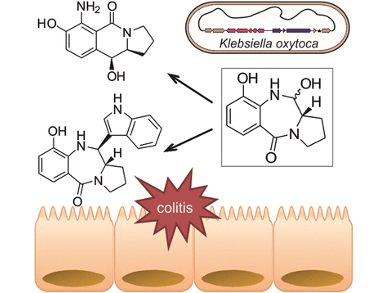Pathobiology of Antibiotic Side Reactions
You get an infection, you are given penicillin—and then you could get hemorrhagic diarrhea. This rare but extremely unpleasant side reaction can be related to the enterotoxin tilivalline produced by a regular intestinal bacterium. Austrian scientists have scrutinized the toxin’s biosynthetic pathway. Their findings give important insights in the pathobiology of antibiotic side reactions and unveil the multifunctionality of bacterial toxins.
Some bacteria are sensitive to penicillin, others are not. While patients swallow antibiotics to destroy harmful microorganisms, their own intestinal microbiota suffers changes. If the introduced unbalance leads to an overgrowth of bacteria producing toxins themselves, intestinal and metabolic disorders can follow. In an interdisciplinary collaboration, Ellen Zechner of the University of Graz, Austria, and her colleagues have researched the role of penicillin-resistant Klebsiella oxytoca enterobacterium in antibiotic-associated hemorrhagic colitis (AAHC).
Enterotoxic Natural Product Tilivalline
They first identified a metabolite tilivalline as a critical enterotoxin, which in higher doses damages the intestinal epithelium and can induce colitis. Surprisingly, tilivalline shares its chemical structure with a class of soil bacteria metabolites called pyrrolobenzodiazepines, which are already investigated and applied in clinical trials for their antitumor properties. After having identified the gene cluster for tilivalline synthesis, the scientists performed comprehensive biomolecular and molecular genetic experiments to track down the complete biosynthetic pathway of tilivalline.
Tilivalline itself lacks the DNA-damaging activity of its antitumor antibiotic relatives because the chemical site crucial for DNA interference is blocked. However, Zechner and colleagues found that the source of the blocking, an indole, only enters the biosynthetic pathway at its end. The tilivalline precursor without the indole, which was then named tilimycin, was shown to be a more potent cytotoxin than tilivalline. Surprisingly, the final addition of the indole to tilimycin occurs spontaneously, without the help of any enzyme. This means that “Klebsiella oxytoca is able to produce two pyrrolobenzodiazepines with distinct functionalities depending on the availability of indole”, the scientists stated. Indole occurs naturally in the human gut.
Both outcomes, the elucidation of the biosynthetic pathway and the discovery of tilimycin as a stable intermediate metabolite, which is even more toxic to human cells, have important physiological and pharmacological implications. First, the better understanding of the AAHC pathogenesis may lead to new treatment schemes and strategies to avoid or just alleviate antibiotic side reactions. And second, the unusual Klebsiella pathway to the anticancerogenic structures can inspire scientists to develop new approaches for producing anticancer drugs.
- Biosynthesis of the Enterotoxic Pyrrolobenzodiazepine Natural Product Tilivalline,
Elisabeth Dornisch, Jakob Pletz, Ronald A. Glabonjat, Florian Martin, Christian Lembacher-Fadum, Margit Neger, Christoph Hçgenauer, Kevin Francesconi, Wolfgang Kroutil, Klaus Zangger, Rolf Breinbauer, Ellen L. Zechner,
Angew. Chem. Int. Ed. 2017.
https://doi.org/10.1002/anie.201707737




